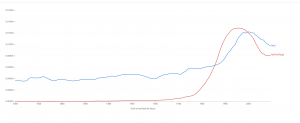This was a my criteria for my curated list:
As I initially scanned through the songs, I had thought by selecting by title. I automatically picked Chuck Berry’s song, immediately recognizing it from Back to the Future. As I continued, however, I realized that I knew very few of the remaining songs by title name and that my initial selection criteria was not going to be effective. Accordingly, I decided my second criteria was going to be that I had to pick songs that were from each continent. I figured since this record is going into space as a representation of music of Earth to whoever finds it, they must have picked songs from all the continents. It is too bad that either wind or some other noise from Antarctica isn’t represented. My final criteria was to select those songs that either elicited feelings and emotions from me or those which I associated to specific memories. This criterion is the one I used most when I finally curated my list to ten songs.
- Track 3: Percussion (Senegal) – Tchenhoukoumen
- This song and its beat made me want to get up and dance. It reminded me of my memories of working for a pharmacy run by our Ugandan family friend, who would expose us to African music.
- Track 5: Morning Star and Devil Bird
- I chose this song, as I appreciated the didgeridoo at the beginning. This intro/hook to this song is what had me listening to the entire clip. The harmony the artist provided with the didgeridoo and then with no music at the end left me with a feeling of wanting more.
- Track 7: Johnny B. Goode
- I chose this song for three reasons. The first being that Chuck Berry was a defining leader for the genre of Rock n’ Roll. The second reason is it reminds me of one of my favourite movies, “Back to the Future” with Michael J. Fox playing this song at the high school dance. The third is my dad and I would have a good time dancing to this song.
- Track 12: Tchakrulo – Choir – Georgia
- I chose this song, as it reminded me about all men’s choir concerts I have gone to see in the past so it brings back good memories. The harmony of simply voices without accompanying instruments gives me goosebumps.
- Track 13: Panpies and Drum (Peru)
- I picked this song, as the drumbeat had me hooked. It reminded me of a rhythm I experienced when I was in Argentina. It was similar to cumbia music I danced to there. I did get sidetracked down the rabbit hole of Argentine cumbia music, but it was a fun side-track.
- Track 14: Melancholy Blues – L Armstrong & His Hot Seven
- I chose this song, as in addition to my appreciation of Louis Armstrong, it brought me back to lessons I have taught about Civil Rights in the USA and the effect of music.
- Track 16: Rite of Spring (Sacrificial Dance)
- I picked this song, as it reminds me of songs that could be in adventure movies such as Indiana Jones. I found it very reminiscent of an action sequence in a film. Although I am not a huge fan of such movies, I was drawn to this song, as it can be translated across many different cultures and languages.
- Track 17: The Well-Tempered Clavier – Bach
- I chose this one because when my children were babies, instead of white noise in their room at night, as parents we played baroque music, on their iPod, for them to fall asleep. This habit continued until they were almost 7 years old. So, this choice is based on pure memory.
- Track 25: Jaat Kahan Ho – Surshri
- I picked this song originally because it had a sitar in it, which brought me back to the pharmacy, where we would listen to international music and have small staff dance parties in the back. Specifically, this music reminded me of Pandit Ravi Shankar. However, I did some digging about this artist and was fascinated to learn that she was a classical vocalist (Wikipedia contributors, 2021).
- Track 26: Dark was the Night – Blind Willie Johnson
- Initially I chose this song, as I appreciated the guitar rhythm and no lyrics. When I did a bit more digging into the artist and his life history, I found that very little is known about the artist. It was also interesting to learn that this artist was a pastor, and this song is his ohmage to Christ’s Crucifixion (Editors Of Encyclopaedia Britannica, 2000).
References:
The Editors Of Encyclopaedia Britannica. (2000, January 12). Blind Willie Johnson | Biography, Songs, & Facts. Encyclopedia Britannica. Retrieved October 24, 2021, from https://www.britannica.com/biography/Blind-Willie-Johnson
Wikipedia contributors. (2021, September 19). Kesarbai Kerkar. Wikipedia. Retrieved October 24, 2021, from https://en.wikipedia.org/wiki/Kesarbai_Kerkar
